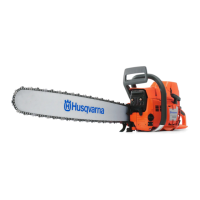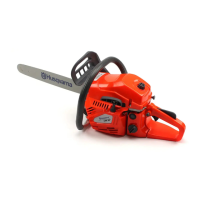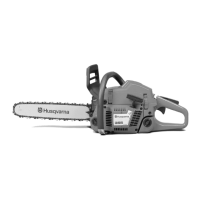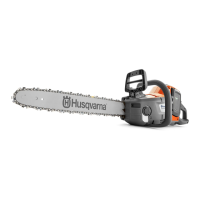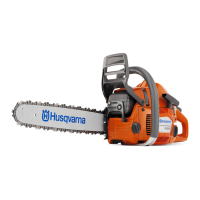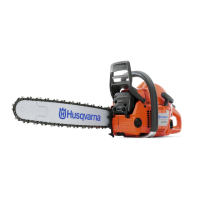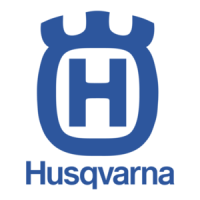
Do you have a question about the Husqvarna 350 (EPA I) and is the answer not in the manual?
Explains the meaning of various symbols used in the manual.
Symbols related to fuel and oil filling procedures.
Details essential protective gear for safe operation of the chainsaw.
Describes safety features and their maintenance.
Explains the function and operation of the chain brake and hand guard.
Details the vibration damping system and its benefits.
Explains the function of the throttle lock to prevent accidental acceleration.
Describes the chain catcher's role in safety.
Explains the purpose of the right hand guard.
Describes how to use the stop switch.
Information about the muffler's function and safety.
Procedures for checking and maintaining safety equipment.
Checking the brake band and hand guard for proper function.
How to test the automatic inertia brake release mechanism.
Verifying the correct operation of the brake trigger.
Checking the functionality of the throttle lock.
Inspecting the chain catcher for damage and secure attachment.
Checking the right hand guard for damage.
Regular checks for cracks or deformation in damping units.
Testing the stop switch for proper operation.
Maintenance and checks for the muffler, including spark arrestor mesh.
Guidelines for selecting and maintaining cutting equipment for safety and performance.
Guidelines for selecting and maintaining cutting equipment for safety and performance.
Information on choosing cutting equipment to reduce kickback risk.
Details about bar characteristics affecting kickback.
Explains chain types and their kickback reduction levels.
Instructions for sharpening cutting teeth and adjusting raker clearance.
Guidance on maintaining sharp cutting teeth for performance and safety.
Detailed steps for sharpening cutting teeth using specific tools.
Steps for adjusting the raker clearance using a file gauge.
Instructions on how to properly tension the saw chain.
Importance and methods of lubricating the chain and bar.
Information on recommended chain oils and their properties.
How to verify that the chain is receiving adequate lubrication.
Procedure for lubricating the bar tip sprocket.
Lubrication of the needle bearing on the drive shaft.
Daily checks for wear on the chain and bar.
Essential techniques and precautions to prevent kickback.
Definition and explanation of kickback phenomenon in chainsaws.
Essential rules for preventing kickback during operation.
Broad safety guidelines for chainsaw use.
Pre-operation checks for safety and functionality.
Procedures for safely starting and stopping the chainsaw engine.
Detailed steps for starting the chainsaw in cold and warm conditions.
Precautions for handling fuel and avoiding fire hazards.
Guidelines for safe transport and storage of the chainsaw.
Basic safety rules and techniques for working with a chainsaw.
Fundamental safety practices for chainsaw operation.
Techniques for efficient and safe cutting.
General principles for using the chainsaw during cutting.
Definitions of common cutting terms like cutting, limbing, splitting.
Key considerations before performing any cut.
Detailed instructions and safety precautions for felling trees.
Maintaining a safe perimeter during tree felling operations.
Factors influencing and controlling the direction of tree fall.
Steps for clearing the felled tree and ensuring a safe exit path.
The technique for making the final felling cut.
How to make directional cuts for controlled felling.
Techniques and safety for removing branches from a felled tree.
Instructions for cutting the felled tree trunk into manageable logs.
Procedures for dealing with fallen trees that are trapped or unstable.
Methods for safely releasing a trapped tree.
Techniques for cutting tensioned wood safely.
A detailed breakdown of chainsaw components and their functions.
Step-by-step guide to attaching the bar and chain to the saw.
Details about the type of gasoline and oil required for the engine.
Instructions on how to correctly mix fuel and oil.
Recommendations for two-stroke oil types and mixtures.
Information on chain oil requirements and lubrication.
Precautions and steps for safely refuelling the chainsaw.
Detailed steps for starting the chainsaw in cold and warm conditions.
Specific starting procedures for a cold engine.
Specific starting procedures for a warm engine.
How to safely stop the chainsaw engine.
Adjusting and maintaining the carburettor for optimal performance.
How the carburettor works and its adjustment procedures.
Fine-tuning the carburettor after the engine has been run-in.
Adjusting the low speed jet for proper engine operation.
Setting the correct idle speed using the T-screw.
Adjusting the high speed jet for optimal power and engine protection.
Information on starter maintenance and replacement.
Steps for replacing a worn or broken starter cord.
How to tension the recoil spring correctly.
Procedures for replacing a broken recoil spring.
Cleaning and replacing the air filter to prevent engine issues.
Checking, cleaning, and replacing the spark plug.
Maintenance and checks for the muffler, including spark arrestor mesh.
Lubricating the needle bearing on the drive shaft.
Adjusting the oil pump for optimal chain lubrication.
Maintaining the cooling system for proper engine temperature.
Maintenance of the air intake system for centrifugal cleaning.
Adjustments and precautions for operating in cold weather.
Routine checks to be performed daily for chainsaw safety and performance.
Maintenance tasks to be performed weekly.
Maintenance tasks to be performed monthly.
Engine specifications like volume, bore, stroke, and speed.
Details about fuel capacity, oil pump, and oil tank.
Weight specifications of the chainsaw.
Specifications for bar length, chain speed, pitch, and drive link thickness.
Guidance on compatible bar and chain combinations for safety.
Detailed specifications for bars, including length, pitch, and radius.
Outlines owner responsibilities and warranty coverage.
Details the scope and duration of the manufacturer's warranty.
Specifies the owner's duties for maintaining warranty.
Defines the warranty duration and what is covered.
Lists covered and excluded parts/situations under warranty.
Steps to follow when filing a warranty claim.
Information on locating authorized service dealers.
List of parts covered under the emission control warranty.



